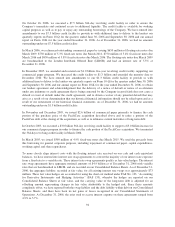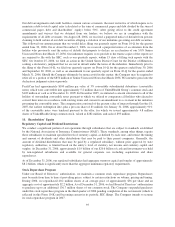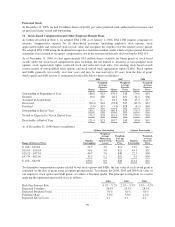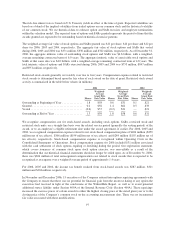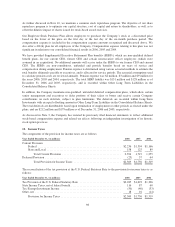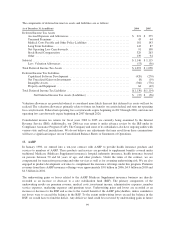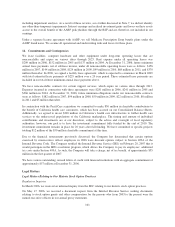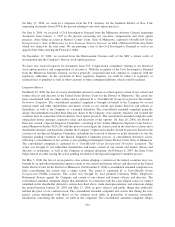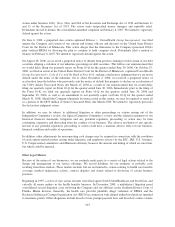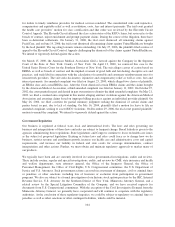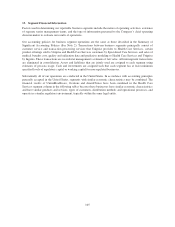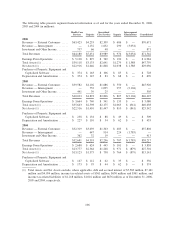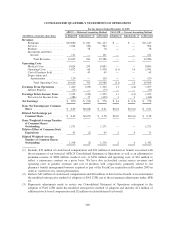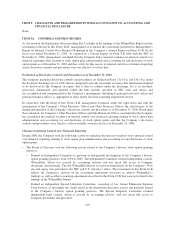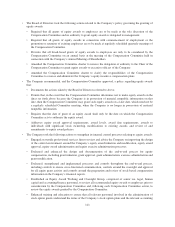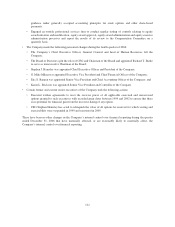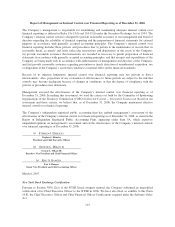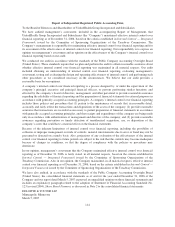United Healthcare 2006 Annual Report Download - page 106
Download and view the complete annual report
Please find page 106 of the 2006 United Healthcare annual report below. You can navigate through the pages in the report by either clicking on the pages listed below, or by using the keyword search tool below to find specific information within the annual report.for failure to timely reimburse providers for medical services rendered. The consolidated suits seek injunctive,
compensatory and equitable relief as well as restitution, costs, fees and interest payments. The trial court granted
the health care providers’ motion for class certification and that order was reviewed by the Eleventh Circuit
Court of Appeals. The Eleventh Circuit affirmed the class action status of the RICO claims, but reversed as to the
breach of contract, unjust enrichment and prompt payment claims. During the course of the litigation, there have
been co-defendant settlements. On January 31, 2006, the trial court dismissed all remaining claims against
PacifiCare, and on June 19, 2006, the trial court dismissed all remaining claims against UnitedHealthcare brought
by the lead plaintiff. The tag-along lawsuits remain outstanding. On July 27, 2006, the plaintiffs filed a notice of
appeal to the Eleventh Circuit Court of Appeals challenging the dismissal of the claims against UnitedHealthcare.
We intend to vigorously defend against the action.
On March 15, 2000, the American Medical Association filed a lawsuit against the Company in the Supreme
Court of the State of New York, County of New York. On April 13, 2000, we removed this case to the
United States District Court for the Southern District of New York. The suit alleges causes of action based on
ERISA, as well as breach of contract and the implied covenant of good faith and fair dealing, deceptive acts and
practices, and trade libel in connection with the calculation of reasonable and customary reimbursement rates for
non-network providers. The suit seeks declaratory, injunctive and compensatory relief as well as costs, fees and
interest payments. An amended complaint was filed on August 25, 2000, which alleged two classes of plaintiffs,
an ERISA class and a non-ERISA class. After the Court dismissed certain ERISA claims and the claims brought
by the American Medical Association, a third amended complaint was filed on January 11, 2002. On October 25,
2002, the court granted in part and denied in part our motion to dismiss the third amended complaint. On May 21,
2003, we filed a counterclaim complaint in this matter alleging antitrust violations against the American Medical
Association and asserting claims based on improper billing practices against an individual provider plaintiff. On
May 26, 2004, we filed a motion for partial summary judgment seeking the dismissal of certain claims and
parties based, in part, due to lack of standing. On July 16, 2004, plaintiffs filed a motion for leave to file an
amended complaint, seeking to assert RICO violations. On December 29, 2006, the trial court granted plaintiffs’
motion to amend the complaint. We intend to vigorously defend against the action.
Government Regulation
Our business is regulated at federal, state, local and international levels. The laws and rules governing our
business and interpretations of those laws and rules are subject to frequent change. Broad latitude is given to the
agencies administering those regulations. State legislatures and Congress continue to focus on health care issues
as the subject of proposed legislation. Existing or future laws and rules could force us to change how we do
business, restrict revenue and enrollment growth, increase our health care and administrative costs and capital
requirements, and increase our liability in federal and state courts for coverage determinations, contract
interpretation and other actions. Further, we must obtain and maintain regulatory approvals to market many of
our products.
We typically have been and are currently involved in various governmental investigations, audits and reviews.
These include routine, regular and special investigations, audits, and reviews by CMS, state insurance and health
and welfare departments, state attorneys general, the Office of the Inspector General, the Office of
Personnel Management, the Office of Civil Rights, U.S. Congressional committees, the U.S. Department of
Justice and U.S. Attorneys. Such government actions can result in assessment of damages, civil or criminal fines
or penalties, or other sanctions, including loss of licensure or exclusion from participation in government
programs. We also are subject to a formal investigation of our historic stock option practices by the SEC, Internal
Revenue Service, U.S. Attorney for the Southern District of New York, Minnesota Attorney General, and a
related review by the Special Litigation Committee of the Company, and we have received requests for
documents from U.S. Congressional committees. With the exception of the Civil Investigative Demand from the
Minnesota Attorney General, we generally have cooperated and will continue to cooperate with the regulatory
authorities. At the conclusion of these regulatory inquiries, we could be subject to regulatory or criminal fines or
penalties as well as other sanctions or other contingent liabilities, which could be material.
104


